
All About Body Composting After Death
Why Body Composting After Death is Revolutionizing Green Funeral Care
Body composting after death is changing how we think about end-of-life care in America. This process, also called natural organic reduction, turns human remains into nutrient-rich soil over 30-60 days using controlled temperature, moisture, and organic materials.
Quick Facts About Body Composting After Death:
- Process Time: 30-60 days for composting + 2-4 weeks curing
- Cost: $2,500-$7,000 (vs $10,000-$15,000 for traditional burial)
- Environmental Impact: Saves 1+ metric tons of CO₂ per body
- Legal Status: Available in 6 states (WA, OR, CO, VT, NY, CA)
- End Product: ~1 cubic yard of pathogen-free soil per body
- Temperature: Maintained at 131-160°F for pathogen elimination
As Laura Muckenhoupt drove home from the Washington facility that had transformed her 22-year-old son Miles into hundreds of pounds of soil, she felt the first glimmer of hope since his death. "We're going to grow him, and we're going to continue to be his parents," she said, capturing why families increasingly choose this regenerative alternative to burial or cremation.
The growing interest in body composting reflects broader concerns about funeral industry environmental impacts. Traditional burials use over 800,000 gallons of toxic embalming chemicals annually in the U.S., while cremation produces an estimated 190 kg of carbon dioxide per body. Human composting uses only one-eighth the energy of modern cremation and creates beneficial soil instead of emissions.
We're American Mortuary Coolers, a national mortuary equipment supplier with extensive experience helping funeral homes adapt to emerging trends like body composting after death. Through years of working with forward-thinking funeral directors, we've seen how green burial methods are reshaping our industry's approach to dignified, sustainable end-of-life care.
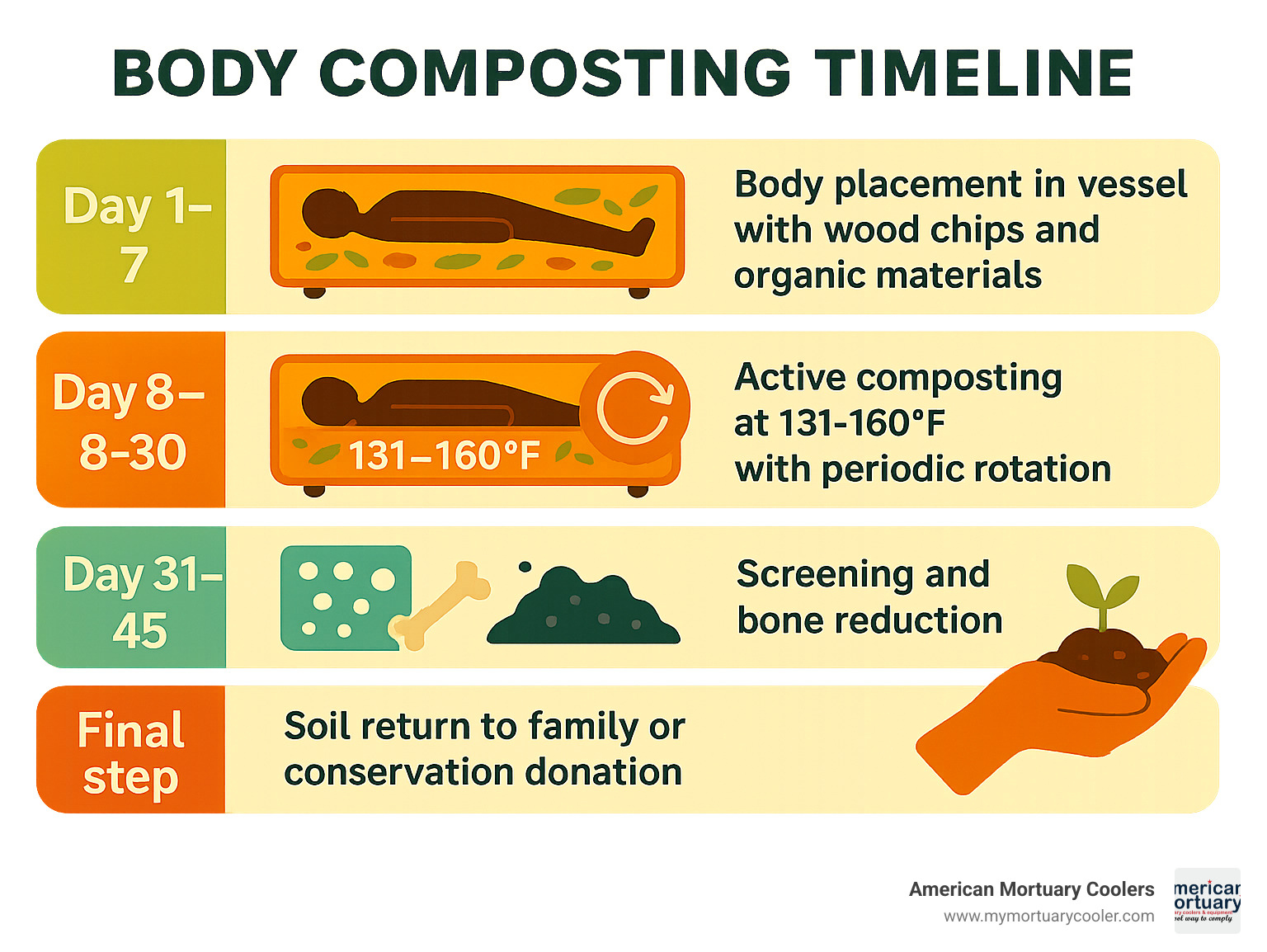
Body Composting After Death: Definition, Names & Early Pioneers
When we talk about body composting after death, we're describing something that nature has been doing for millions of years—just with a little human engineering to make it faster and safer. Officially called natural organic reduction (NOR), this process takes the same decomposition that happens on forest floors and speeds it up in controlled conditions.
The concept isn't entirely new. Farmers have been using mortality composting to safely handle deceased livestock for decades, proving that controlled decomposition works beautifully for managing organic matter. What is new is adapting this time-tested method for human remains with the dignity and care families deserve.
The modern human composting movement really took off when visionary companies like Recompose and Return Home started developing specialized vessels and protocols. These pioneers didn't just create a business—they created an entirely new category of death care that gives families a genuinely regenerative option.
Washington state broke new ground in 2019 by becoming the first to legalize body composting after death. The legislation came after years of research and public discussion about sustainable alternatives to traditional burial and cremation. Scientific research on funeral emissions has since validated what early advocates suspected—this method dramatically reduces environmental impact compared to conventional options.
Here's how the science works: Human remains are placed in specially designed steel vessels along with carefully selected organic materials like wood chips and alfalfa. Natural microbes do the heavy lifting, breaking down tissues over 30-60 days while the system maintains temperatures between 131-160°F. This heat range isn't random—it's hot enough to eliminate pathogens but cool enough to preserve beneficial microorganisms.
The end result? Roughly one cubic yard of rich, dark soil per body—that's about 500 to over 1,000 pounds of nutrient-dense compost that can nourish new life for generations.
Key Terms Around Body Composting After Death
Natural Organic Reduction (NOR) is the official scientific name that appears in legislation and research papers. It sounds clinical, but it perfectly describes what's happening—organic matter naturally reducing to its essential components.
Terramation is Return Home's trademarked term for their specific approach to the process. The name combines "terra" (earth) and the concept of change, emphasizing the soil-to-soil cycle.
Human composting is what most people call it in everyday conversation. It's the term you'll see in news articles and family discussions, even though some in the industry prefer more technical language.
Cradle-to-soil cycle captures the philosophical approach—instead of "cradle to grave," this process creates a complete circle where human remains become the foundation for new growth.
How Human Composting Works Step-by-Step
The body composting after death process is like nature's own recycling system, but carefully controlled and accelerated. Having worked with funeral homes setting up these systems, I can tell you it's fascinating to see how science meets compassion to create something truly meaningful.
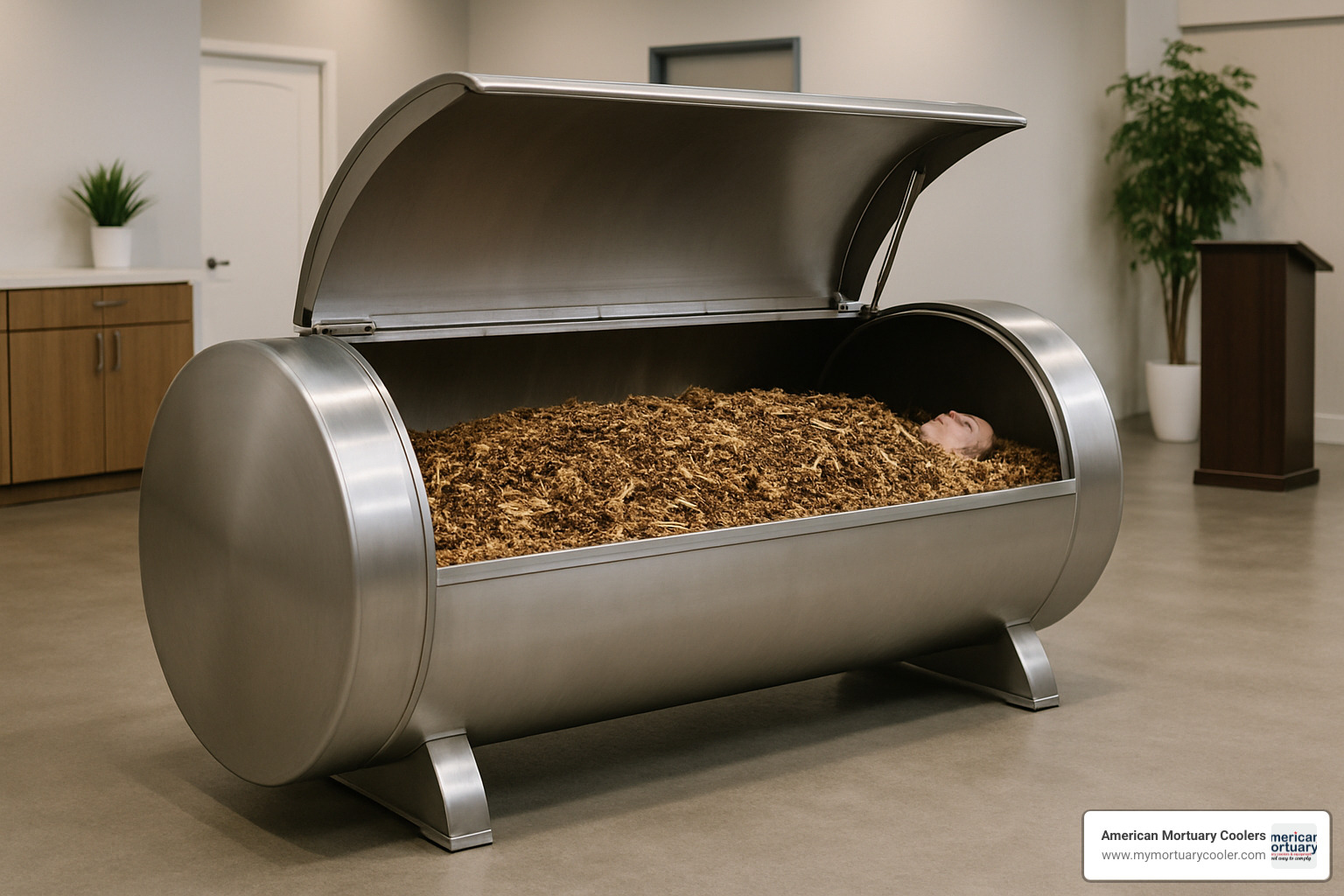
Everything starts with a specially designed vessel that looks like a large stainless steel cylinder - about 8 feet long and 4 feet tall. The body is gently placed inside and surrounded by a thoughtfully chosen mix of organic materials. This isn't random; it's carefully calculated to create the perfect environment for natural decomposition.
The secret lies in getting the carbon-to-nitrogen ratio just right - around 30:1. Think of it like a recipe where wood chips provide the carbon, alfalfa adds nitrogen, and straw helps everything breathe. This combination feeds the beneficial microbes that do the actual work of change.
Temperature is absolutely critical during body composting after death. The vessel needs to stay between 130-160°F for at least 72 hours straight. This heat comes naturally from microbial activity - the same process that makes your backyard compost pile warm. But unlike your garden compost, sophisticated monitoring systems track every degree to ensure safety.
The active phase typically runs 30-60 days, with the vessel being rotated periodically. This rotation ensures even decomposition and proper airflow throughout the material. After this phase, the contents are carefully screened to remove any non-organic items like dental work or medical implants.
Any remaining bone fragments get mechanically reduced to powder and mixed back into the soil. Then comes a 2-4 week curing period in aerated bins, allowing the compost to stabilize and mature. Finally, comprehensive lab testing confirms the soil meets all safety standards before families receive it.
| Method | Duration | Energy Use | CO₂ Impact | Cost Range |
|---|---|---|---|---|
| Traditional Burial | 1-2 weeks | Moderate | High (casket production, transport) | $10,000-$15,000 |
| Cremation | 2-4 hours | High | 190 kg CO₂ per body | $6,000-$8,000 |
| Body Composting | 30-60 days | 1/8 of cremation | 1+ metric ton CO₂ saved | $2,500-$7,000 |
Materials & Conditions Needed for Success
Success in body composting after death comes down to creating the perfect environment for beneficial microbes to thrive. The wood chips provide carbon for microbial food, create air pockets for oxygen flow, and soak up excess moisture. Alfalfa brings the nitrogen that microbes need to multiply and work efficiently. Straw acts like tiny scaffolding, keeping the whole mixture from getting too compact.
Maintaining 50% moisture throughout the process is crucial. Too dry, and the microbes can't do their work. Too wet, and you risk creating anaerobic conditions that could cause problems. Modern facilities use forced aeration systems to keep oxygen flowing consistently through the material.
The monitoring technology is impressive - sensors track temperature, moisture, oxygen levels, and pH in real-time. This isn't a "set it and forget it" process. It requires constant attention to ensure everything stays within the optimal ranges for safe, effective decomposition.
Health & Safety Protocols in Body Composting After Death
Safety is paramount in body composting after death, and the protocols are rigorous. That 55°C temperature maintained for 72 consecutive hours isn't just a guideline - it's a strict requirement that eliminates dangerous pathogens like E. coli and Salmonella. This pasteurization process actually exceeds safety standards used in many other composting applications.
Not everyone can go through this process. People who died from prion diseases like Creutzfeldt-Jakob disease are excluded because these proteins are incredibly resistant to breakdown and could pose risks. It's a necessary precaution that protects both workers and the final soil product.
The final compost undergoes extensive lab testing to verify it's completely safe. Workers follow strict protocols with proper PPE, and facilities use biofilters to manage any odors during the process. These aren't just good practices - they're required by law in states where this process is legal.
For more detailed information about the technical aspects, visit our guide on the body composting process.
Environmental & Financial Benefits
When families choose body composting after death, they're making a decision that benefits both their wallets and the planet. Each person who takes this path prevents roughly one metric ton of CO₂—about the same as driving 2,500 miles—and the process uses only one-eighth the energy required for cremation.
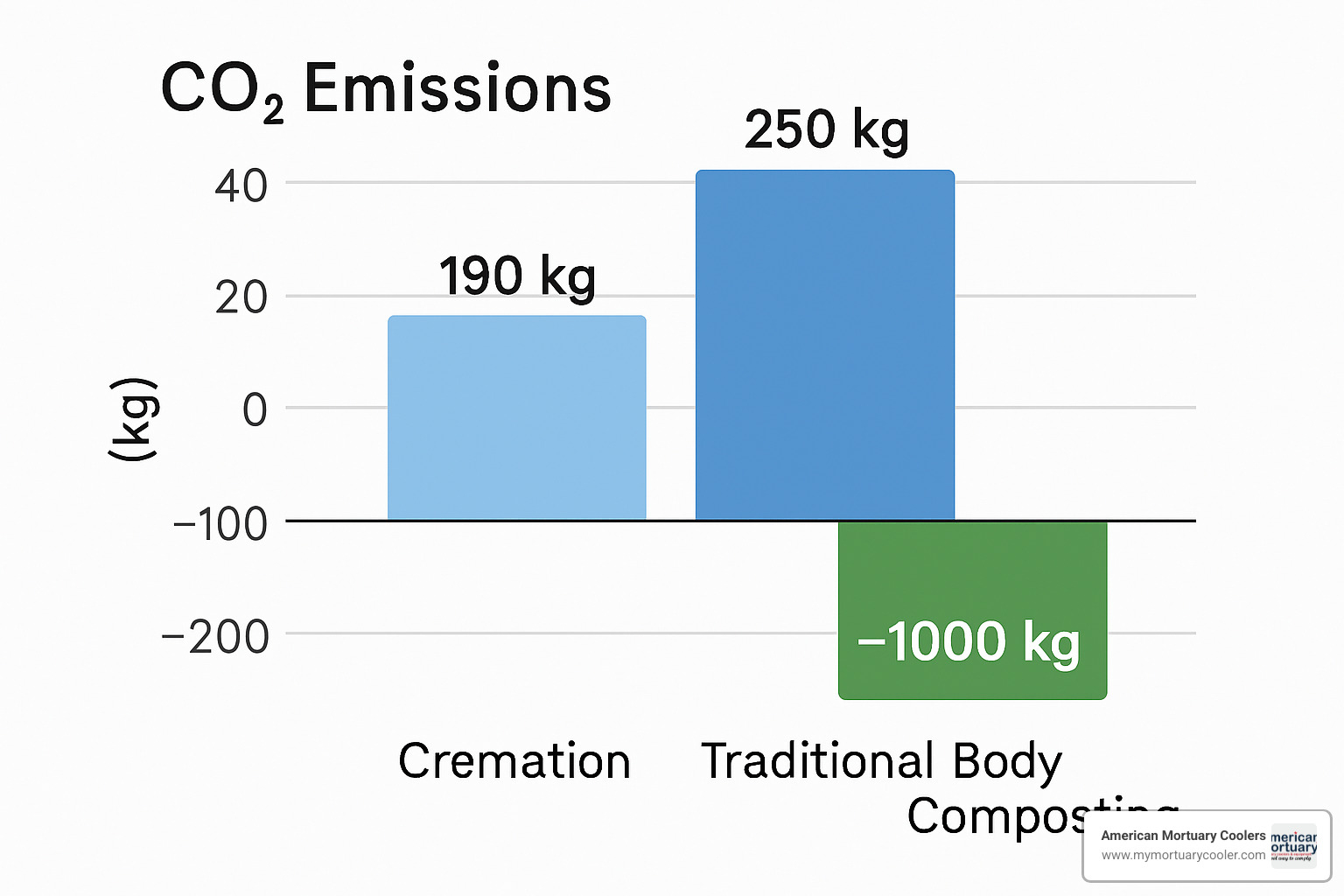
Traditional burials rely on caskets, vaults, and embalming fluids that introduce toxins and consume natural resources, while cremation demands the equivalent of 28 gallons of fuel and releases mercury from dental fillings. Human composting produces a cubic yard of nutrient-rich soil with no harmful by-products and can help restore forests, gardens, or conservation lands.
Financially, the service averages $2,500–$7,000, far less than a conventional burial’s $10,000–$15,000 and comparable to cremation. Most providers bundle body care, the full composting cycle, screening, lab testing, and either soil return or donation, so families avoid surprise cemetery or vault fees.
Body Composting After Death vs. Traditional Options
Every year U.S. cemeteries add 1.6 million tons of concrete and steel and 4.3 million gallons of embalming fluid to the ground. Cremation saves land but emits about 190 kg of CO₂ per body. Natural organic reduction is carbon-negative, needs no new land, and leaves behind soil with a plant-friendly pH of 6.5–7.
For deeper comparisons, explore our human composting options. Recent scientific research on carbon savings confirms that natural organic reduction is the most climate-friendly funeral choice currently available.
Laws, Locations & Oversight
The legal journey for body composting after death has been remarkable to watch unfold. What started as a single pioneering law in Washington has grown into a movement spanning six states, with more joining each year.
Washington broke ground in 2019 as the first state to legalize natural organic reduction. Oregon, Colorado, and Vermont followed in quick succession, with New York joining in 2022. California passed legislation that will take effect in 2027, bringing the total to six states where families can choose this option.
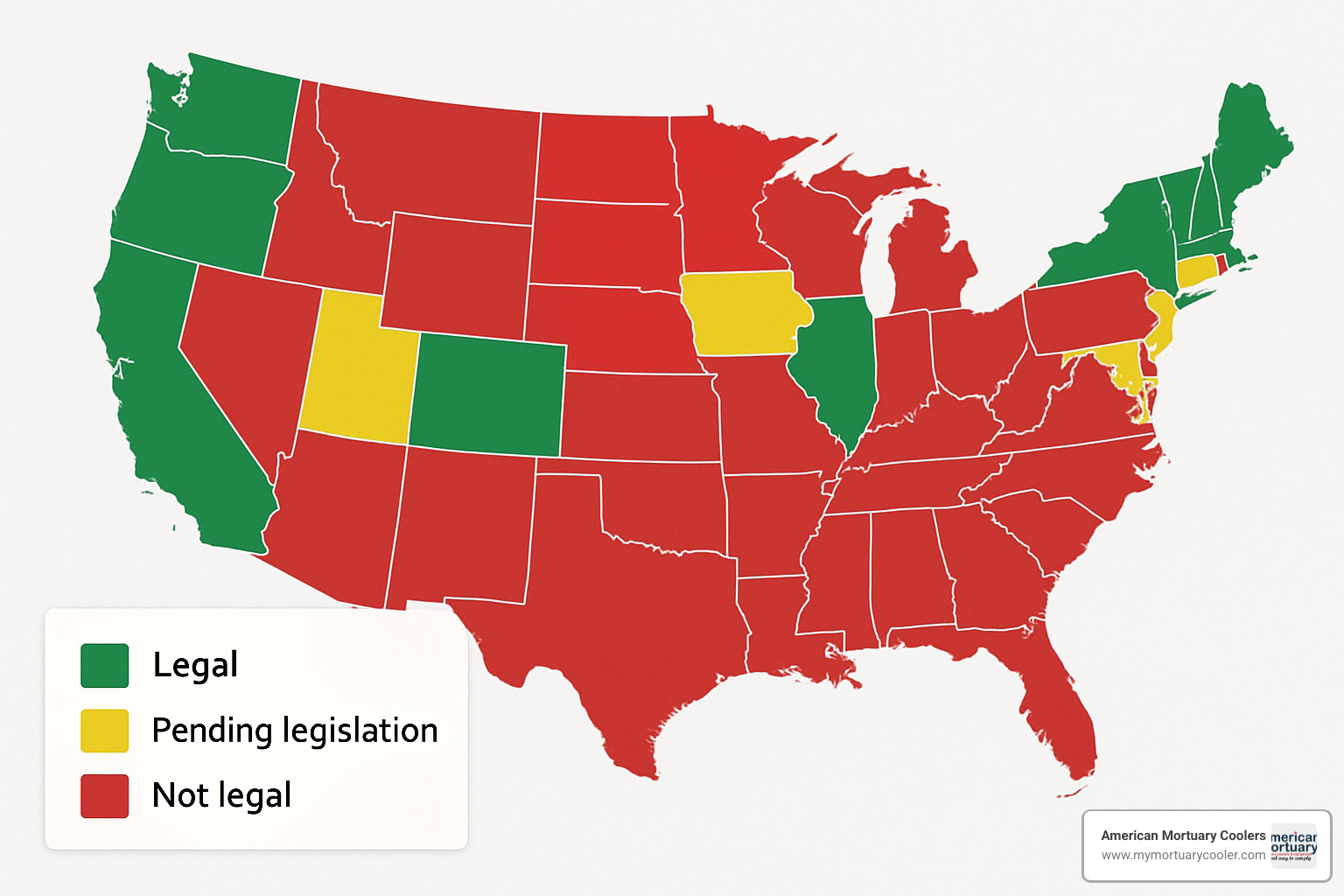
Each state has crafted regulations that prioritize both safety and dignity. Temperature rules are consistent across states - facilities must maintain at least 131°F for 72 consecutive hours to ensure pathogen elimination. Operator licensing requirements vary but typically include specialized training on the composting process, safety protocols, and family support.
The regulatory framework addresses practical concerns like soil-use restrictions. Most states prohibit using the finished compost on food crops, limiting application to ornamental plants, trees, and conservation projects. This makes sense from a public health perspective while still allowing meaningful use of the soil.
What's exciting is the momentum building for 2024. Delaware, Hawaii, Maine, Massachusetts, Minnesota, Nevada, and Rhode Island all have pending bills under consideration. Each state learns from the others, often improving regulations based on real-world experience from early adopters.
Oversight typically falls under state health departments or professional licensing boards. These agencies handle facility permits, conduct inspections, and ensure compliance with safety standards. The regulatory approach has been thoughtful - strict enough to ensure safety while flexible enough to allow innovation.
For families considering this option, understanding your state's specific requirements matters. Colorado, for example, has particularly detailed provisions for facility design and operation. Our Colorado laws guide walks through these requirements in detail.
Where Can Families Spread or Donate the Soil?
The question of what to do with roughly one cubic yard of soil - that's 500 to 1,000 pounds - is deeply personal for families. Most states give families flexibility while maintaining reasonable safety guidelines.
Private land permission is the most common option. Families can use the soil on their own property or with a landowner's consent. We've heard beautiful stories of families creating memorial gardens, planting oak trees, or enhancing existing landscapes with their loved one's soil.
Many families choose conservation projects instead of taking the soil home. Recompose has donated thousands of pounds of soil to forest restoration efforts in Washington and California. These projects help restore damaged ecosystems while creating lasting environmental legacies.
The food-crop limits make sense from a regulatory standpoint. While the finished compost is thoroughly tested and safe, most states err on the side of caution by restricting use to ornamental plants, trees, and shrubs. This still allows for meaningful memorial plantings without raising food safety concerns.
Provider Support & Family Experience
The human side of body composting after death is where providers really shine. This isn't just about the technical process - it's about supporting families through one of life's most difficult transitions.
Laying-in ceremonies have become increasingly popular. These services allow families to say goodbye before the composting process begins, often incorporating personal touches like favorite flowers, photographs, or meaningful objects. The ceremony provides closure while honoring the choice to give back to the earth.
Virtual streaming has opened access for families spread across the country. Since many facilities serve multiple states, this technology ensures distant relatives can participate in ceremonies and feel connected to the process.
Grief resources are essential because choosing body composting after death often means families are navigating uncharted emotional territory. Providers increasingly offer counseling referrals, support groups, and educational materials specifically for families choosing natural organic reduction.
For those new to the concept, our Terramation guide provides comprehensive information about what families can expect throughout the entire process.
Criticisms, Ethics & Religious Perspectives

Acceptance of body composting after death is growing but not universal. Some Catholic and Orthodox Jewish leaders still prefer traditional burial, while others point to religious calls for environmental stewardship as grounds for acceptance. Many Protestant, Indigenous, and secular communities already view human composting as a respectful return to the earth.
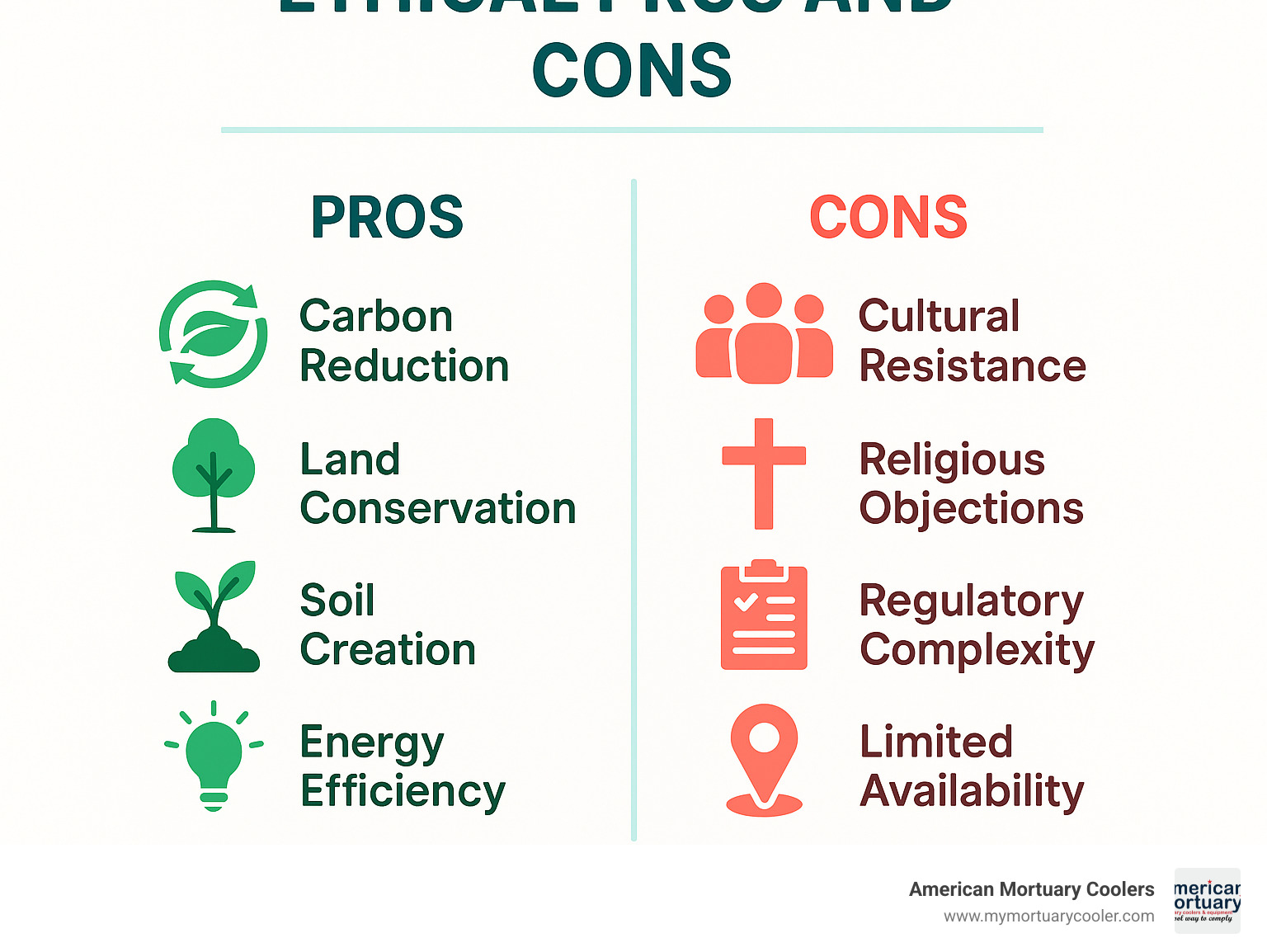
Public-health concerns about pathogens, chemicals, or airborne emissions are addressed through strict temperature controls, moisture management, and mandatory lab testing. Studies near existing facilities report no adverse community impacts, and modern biofilters keep odors to a minimum.
The greatest hurdle is cultural: many families simply feel unready for a new practice. As more positive stories emerge and regulations standardize, familiarity—and comfort—are expected to increase.
Knowledge Gaps & Future Research Needs
Ongoing studies are exploring long-term soil monitoring, improved prion inactivation, and the psychological effects on grieving families. Continued research will refine best practices and build public confidence in this emerging form of green funeral care.
Frequently Asked Questions about Body Composting After Death
How long does the full process take?
The complete body composting after death process takes about 8-12 weeks from beginning to end. Most families find this timeframe gives them space to process their grief while knowing their loved one is being transformed into something meaningful.
The first phase involves 30-60 days of active composting inside the specially designed vessel. During this time, natural microbes work steadily to break down soft tissues while temperatures stay between 131-160°F. Think of it like nature's own recycling system, just carefully controlled and monitored.
After the active phase comes 2-4 weeks of curing and screening. This is when the compost gets to "rest" and stabilize while beneficial microorganisms finish their important work. The material is also screened to remove any non-organic items like medical implants or dental work.
The exact timeline can shift based on factors like body size, the specific facility's protocols, and how long final testing takes. But most providers keep families updated throughout the process, so you'll know what's happening when.
Is the resulting soil safe for gardens?
Absolutely - the soil from body composting after death is completely safe for garden use, though most states limit it to ornamental plants rather than vegetables or herbs. The science behind this safety is pretty impressive.
The composting process includes what's essentially pasteurization at high temperatures that wipes out any harmful pathogens. We're talking about sustained heat that eliminates things like E. coli and Salmonella - the same principle used in food safety. Then comprehensive lab testing double-checks everything before families receive their soil.
The finished compost has a neutral pH between 6.5-7 and a balanced nutrient profile that plants absolutely love. Many families create beautiful memorial gardens, plant tree groves, or establish flower beds using the soil. The high organic matter content means it holds water well and provides slow-release nutrients - basically, it's premium garden soil.
You'll often see families planting roses, establishing small forests, or creating peaceful garden spaces where they can visit and remember. It's a living memorial that keeps growing and changing with the seasons.
How much does body composting after death cost?
Body composting after death typically runs $2,500 to $7,000 for complete services, making it significantly more affordable than traditional burial and competitive with cremation costs. For many families, this represents substantial savings while choosing an environmentally responsible option.
To put this in perspective, traditional burial often costs $10,000-$15,000 when you factor in the casket, burial plot, headstone, and various services. Cremation usually runs $6,000-$8,000 including the service and urn. Human composting falls right in the middle cost-wise but offers unique benefits neither traditional option provides.
Most providers offer comprehensive packages that include everything: body care, the entire composting process, screening and testing, and either soil return to the family or donation to conservation projects. Some facilities even offer payment plans or financing options to make the service more accessible to families.
Additional costs might include transportation if you're coming from out-of-state, or optional ceremony services if you want a more traditional memorial component. But the base price typically covers everything needed for the complete change process.
The cost reflects the specialized equipment, careful monitoring, extensive testing, and time investment required. But many families find the combination of environmental benefits, cost savings, and meaningful end result makes body composting after death an excellent value compared to traditional options.
Conclusion
Body composting after death is quietly changing how American families think about saying goodbye. What started as a bold experiment in Washington state has grown into a movement that's helping thousands of families honor their loved ones while healing the earth.
The numbers tell a powerful story. Each person who chooses human composting prevents a metric ton of CO₂ from entering our atmosphere. That's like taking a car off the road for 2,500 miles. The resulting soil - rich, dark, and full of life - goes on to nourish trees, flowers, and conservation projects across the country.
We've watched this change at American Mortuary Coolers. Over the past few years, funeral directors from Tennessee to California, Chicago to Atlanta have asked us about equipment for green burial services. They're responding to families who want something different - something that feels more like a beginning than an ending.
The legal landscape keeps expanding too. Six states now allow body composting after death, with more considering legislation each year. What once seemed impossible is becoming routine, with facilities operating safely and successfully across multiple states.
For families facing end-of-life decisions, the choice often comes down to values. Traditional burial and cremation have served us well, but they come with environmental costs that many people can no longer ignore. Human composting offers a third path - one that transforms loss into renewal.
The process itself has evolved beautifully. Modern facilities blend cutting-edge science with genuine compassion. Families can hold ceremonies, visit during the process, and receive soil that literally carries their loved one forward. It's death care that honors both human dignity and our planet's future.
Cost matters too, especially for families already dealing with grief. At $2,500 to $7,000, human composting costs less than traditional burial while delivering something priceless - the knowledge that your loved one continues nurturing life.
As funeral professionals explore these options, having the right equipment makes all the difference. That's where we come in. Our custom mortuary solutions help funeral homes adapt to changing needs while maintaining the highest standards of care and dignity.
The future of death care is becoming more sustainable, more meaningful, and more connected to the natural world. Body composting after death isn't just an alternative - it's a return to something ancient and essential about how we honor life.
To learn more about our mortuary equipment solutions and how we support innovative funeral services, visit our website. We're here to help funeral professionals provide the dignified, sustainable services that today's families increasingly seek.



